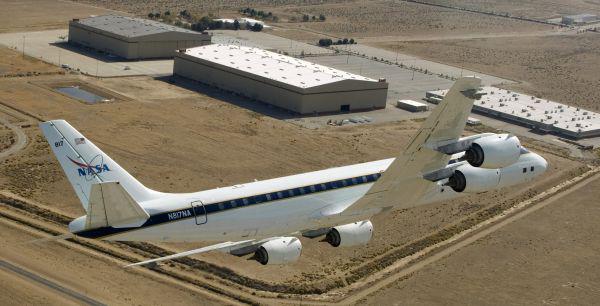NASA Tests Biofuels for Environmental Effects, Performance
NASA is in the midst of its first phase of flight tests to determine the effects of alternative biofuels on the emissions and performance of jet engines flying at altitude.
The program is called the Alternative Fuel Effects on Contrails and Cruise Emissions, or ACCESS, according to Dr. Ruben Del Rosario, project manager of NASA’s Subsonic Fixed Wing project. The goal is to investigate how biofuels perform compared with traditional jet fuel and also to measure the environmental impact of biofuels. The results of the tests are significant because of the growing popularity of biofuels for both the U.S. Air Force and Navy as well as private sector aviation.
During the ACCESS tests, the space agency’s highly modified Douglas DC-8, which normally is used as a flying laboratory, will conduct a series of flights at altitudes as high as 40,000 feet, while a NASA Falcon HU-25 aircraft follows behind at distances of between 300 feet and more than 10 miles, according to Del Rosario. The flights will take place primarily over restricted airspace over Edwards Air Force Base in California.
ACCESS is the outgrowth of earlier preliminary research on biofuels and jets. “It was born out of two previous experiments that we conducted in 2009 and 2011 at NASA’s Dryden Aircraft Operations Facility,” Del Rosario explains. During those tests, ground-based instruments measured the exhaust emissions of the DC-8 while the plane was parked on a ramp at the Palmdale, California, facility.
“During the ground tests, we took very detailed emission measurements, measuring CO2 [carbon dioxide], different oxides, different particulates, measuring sulfur, all the different kind of emissions we could possibly measure with many other companies and institutions joining us, as well,” Del Rosario says.
The ground tests and their results led to the decision to initiate the in-flight tests, he adds, because the ground tests didn’t tell the whole story. “There are some test correlations that don’t translate well between the ground measurements and what we can obtain in-flight during cruising conditions. We couldn’t run the engines at 100 percent power while we were parked on the ground, and that doesn’t really simulate flying at cruise conditions,” he explains. In some cases, the measurements will examine contrails on a second-by-second basis.
During in-flight ACCESS tests, the DC-8’s four CFM56 engines will burn conventional JP-8 jet fuel on some flights, and a 50-50 mix of JP-8 and an alternative fuel composed of hydroprocessed esters and fatty acids from camelina plants, a biofuel certified for use by the Air Force on other flights. “You start out with a biomass, which can be from a plant or from animal fat, and you get a fuel that can mix and burn with approximately the same characteristics of JP-8,” Del Rosario says.
Biofuels have been in use for both military and civilian aviation for more than three years, and from a performance standpoint, it has become just as reliable as the 100 percent JP-8 fuels that it is replacing. “What we’re trying to understand is the emissions part of the fuels. Even though they behave like JP-8, they have lower sulphur levels, for example,” he explains. Sulphur is one of the elements that generate particulates, and those particulates are one of the factors in the creation of high altitude contrails that lead to air pollution.
The ACCESS program will take 15 different measurements over 15-to-20 flight-hours worth of tests, which began on February 28, and tests are expected to continue through the end of March. Del Rosario says that by early this summer, NASA expects to sponsor a workshop to be attended by all of the stakeholders and researchers with an interest in the results to pore over the data. Participants also will receive a copy of all test data so that they can perform their own analysis. At the end of the summer, a second workshop is planned to review all of the analysis. Scientists also will determine what additional tests, if any, will take place when NASA conducts a second round of in-flight tests sometime in 2014.
The ACCESS study is a joint project involving researchers at Dryden, NASA’s Glenn Research Center in Cleveland and NASA’s Langley Research Center in Hampton, Virginia.





Comments